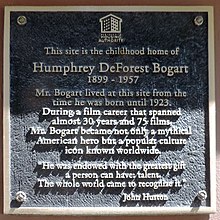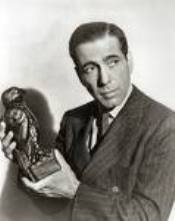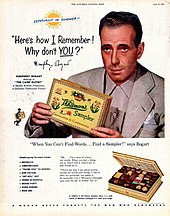Humphrey Bogart
In 1947, he played a war hero in another noir, Dead Reckoning, tangled in a dangerous web of brutality and violence as he investigates his friend's murder, co-starring Lizabeth Scott.
[6] He reprised those unsettled, unstable characters as a World War II naval-vessel commander in The Caine Mutiny (1954), which was a critical and commercial hit and earned him another Best Actor nomination.
Clifford McCarty wrote that Warner Bros. publicity department had altered it to January 23, 1900, "to foster the view that a man born on Christmas Day couldn't be as villainous as he appeared to be on screen".
[47] Although Bogart had been raised to believe that acting was a lowly profession, he liked the late hours actors kept and the attention they received: "I was born to be indolent and this was the softest of rackets.
[52] He played a juvenile lead (reporter Gregory Brown) in Lynn Starling's comedy Meet the Wife, which had a successful 232-performance run at the Klaw Theatre from November 1923 through July 1924.
[64] Although Leslie Howard was the star, The New York Times critic Brooks Atkinson said that the play was "a peach ... a roaring Western melodrama ... Humphrey Bogart does the best work of his career as an actor.
The studio tested several Hollywood veterans for the Duke Mantee role and chose Edward G. Robinson, who had star appeal and was due to make a film to fulfill his contract.
Bogart rarely watched his own films and avoided premieres, issuing fake press releases about his private life to satisfy journalistic and public curiosity.
[94] High Sierra (1941, directed by Raoul Walsh) featured a screenplay written by John Huston, Bogart's friend and drinking partner, adapted from a novel by W. R. Burnett, author of the novel on which Little Caesar was based.
Based on the Dashiell Hammett novel, it was first serialized in the pulp magazine Black Mask in 1929 and was the basis of two earlier film versions; the second was Satan Met a Lady (1936), starring Bette Davis.
Fearing that it would be nothing more than a sanitized version of the pre-Production Code The Maltese Falcon (1931), Raft turned down the role to make Manpower with director Raoul Walsh, with whom he had worked on The Bowery in 1933.
[101] Bogart played his first romantic lead in Casablanca (1942): Rick Blaine, an expatriate nightclub owner hiding from a suspicious past and negotiating a fine line among Nazis, the French underground, the Vichy prefect and unresolved feelings for his ex-girlfriend.
Bosley Crowther wrote in his November 1942 New York Times review that Bogart's character was used "to inject a cold point of tough resistance to evil forces afoot in Europe today".
[102] The film, directed by Michael Curtiz and produced by Hal Wallis, featured Ingrid Bergman, Claude Rains, Sydney Greenstreet, Paul Henreid, Conrad Veidt, Peter Lorre and Dooley Wilson.
Bogart was attracted by Bacall's high cheekbones, green eyes, tawny blond hair, lean body, maturity, poise and earthy, outspoken honesty;[115] he reportedly said, "I just saw your test.
"[122] Months after wrapping To Have and Have Not, Bogart and Bacall were reunited for an encore: the film noir The Big Sleep (1946), based on the novel by Raymond Chandler with script help from William Faulkner.
"[123] Although the film was completed and scheduled for release in 1945, it was withdrawn and re-edited to add scenes exploiting Bogart and Bacall's box-office chemistry in To Have and Have Not and the publicity surrounding their offscreen relationship.
At the insistence of director Howard Hawks, production partner Charles K. Feldman agreed to a rewrite of Bacall's scenes to heighten the "insolent" quality which had intrigued critics such as James Agee and audiences of the earlier film, and a memo was sent to studio head Jack Warner.
He and Bacall married in a small ceremony at the country home of Bogart's close friend, Pulitzer Prize-winning author Louis Bromfield,[86] at Malabar Farm (near Lucas, Ohio) on May 21, 1945.
He found the sea a sanctuary[134] and spent about thirty weekends a year on the water, with a particular fondness for sailing around Catalina Island: "An actor needs something to stabilize his personality, something to nail down what he really is, not what he is currently pretending to be.
Directed by John Huston, Edward G. Robinson was billed second (behind Bogart) as gangster Johnny Rocco: a seething, older synthesis of many of his early bad-guy roles.
Riding high in 1947 with a new 15-year contract with Warners which provided limited script refusal and the right to form his own production company, Bogart rejoined with John Huston for The Treasure of the Sierra Madre: a stark tale of greed among three gold prospectors in Mexico.
In addition to pressure from freelancing actors such as Bogart, James Stewart, and Henry Fonda, they were beginning to buckle from the impact of television and the enforcement of antitrust laws which broke up theater chains.
Bogart plays Dixon Steele, an embittered writer with a violent reputation who is the primary suspect in the murder of a young woman and falls in love with failed actress Laurel Gray (Gloria Grahame).
[154] Huston's love of adventure, his deep, longstanding friendship (and success) with Bogart, and the chance to work with Hepburn convinced the actor to leave Hollywood for a difficult shoot on location in the Belgian Congo.
"[157] Hepburn (a teetotaler) fared worse in the difficult conditions, losing weight and at one point becoming very ill. Bogart resisted Huston's insistence on using real leeches in a key scene where Charlie has to drag his steam launch through an infested marsh, and reasonable fakes were employed.
Despite the acrimony, the film was successful; according to a review in The New York Times, Bogart was "incredibly adroit ... the skill with which this old rock-ribbed actor blends the gags and such duplicities with a manly manner of melting is one of the incalculable joys of the show".
In the late 1990s, Bacall donated the only known kinescope of the 1955 performance (in black and white) to the Museum of Television & Radio (now the Paley Center for Media), where it remains archived for viewing in New York City and Los Angeles.
In the spring of 1955, after a long party in Las Vegas attended by Frank Sinatra, Judy Garland and her husband Sidney Luft, Michael Romanoff and his wife Gloria, David Niven, Angie Dickinson and others, Bacall surveyed the wreckage and said: "You look like a goddamn rat pack.
Among those who attended Bogart's funeral were Ingrid Bergman, Mary Astor, Olivia de Havilland, Bing Crosby, James Cagney, Henry Fonda, Harry Cohn, David O. Selznick and Jack L. Warner.

























